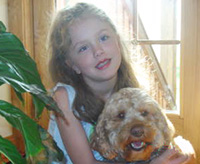Signs & Symptoms of Autism
 The alternate neurological structuring that is defined as autism causes two primary differences in the way that people with autism process information. The behavioral characteristics of autism are easier to understand if one can appreciate these neurological differences:
The alternate neurological structuring that is defined as autism causes two primary differences in the way that people with autism process information. The behavioral characteristics of autism are easier to understand if one can appreciate these neurological differences:
- People with autism have more of their brains activated for every sensory experience. For people with autism, each experience is made louder, brighter, and bigger.
- To compound this problem, people with autism process sensory experience more slowly than people without the condition.
Many autistic behaviors, such as stimming and perseveration, are an attempt to control uncomfortable sensory experience. Other behaviors, such as meltdowns, are a result of being overwhelmed past the ability to self-regulate.
The important idea to understand is that when people with autism behave differently, they are not being willful or spoiled; they are simply trying to cope in a world that is too intense and moves more quickly than they can process it.
Linguistic Indicators of ASD
- Does not babble, point, or make meaningful gestures by 1 year of age
- Does not speak one word by 16 months
- Does not combine two words by 2 years
- Does not respond to name
- Loses language or social skills
Since children with autism have difficulty differentiating sensory experience, including the experience of the people around them, they are often delayed in these social developmental milestones. These sensory issues also affect fine and gross motor development, making physical actions like pointing and verbal communication difficult.
Social Indicators of ASD
 Poor eye contact
Poor eye contact- Doesn’t seem to know how to play with toys
- Doesn’t smile
- At times seems to be hearing impaired
Maintaining eye contact and knowing how to play with toys are both learned social behaviors. Since social skills are generally learned through observation, people with autism take longer to develop these social rules due to the additional time it takes to process this experience.
Similarly, knowing when to smile and knowing how to respond to other people’s spoken language are two learned skills that require additional time to learn.
Behavioral Indicators of ASD
- Performs repetitive movements, such as rocking, spinning or hand-flapping
- Develops specific routines or rituals
- Becomes disturbed at the slightest change in routines or rituals
- Excessively lines up toys or other objects
- Is attached to one particular toy or object
- May be fascinated by parts of an object, such as the spinning wheels of a toy car
 Since the world is an overwhelming place for people with autism, they welcome any order that they can give to it. People with autism use stimming behaviors, like rocking and hand-flapping, as a way to control their sensory experience. Similarly, people on the spectrum use routines and rituals to bring order to a world that is chaotic and difficult to understand.
Since the world is an overwhelming place for people with autism, they welcome any order that they can give to it. People with autism use stimming behaviors, like rocking and hand-flapping, as a way to control their sensory experience. Similarly, people on the spectrum use routines and rituals to bring order to a world that is chaotic and difficult to understand.
Lining up toys and other objects is calming and is another way that people with autism control the world around them. Also, due to their sensory processing issues, people on the spectrum may feel more comfortable focusing on specific parts of an object instead of utilizing the entire object within its social context. Further, once someone with autism has gained familiarly with an object, they often want to keep it with them as a source of reliability and comfort.
Providing Autism Support in Pennsylvania
412-781-4116 800-827-9385 support@AutismOfPA.org